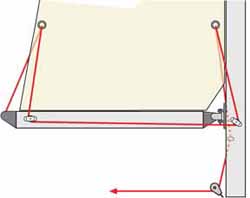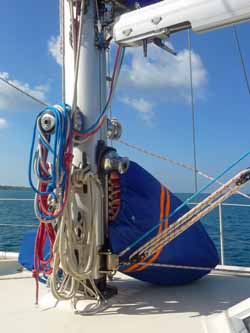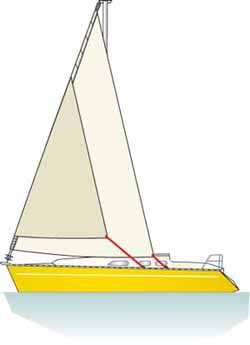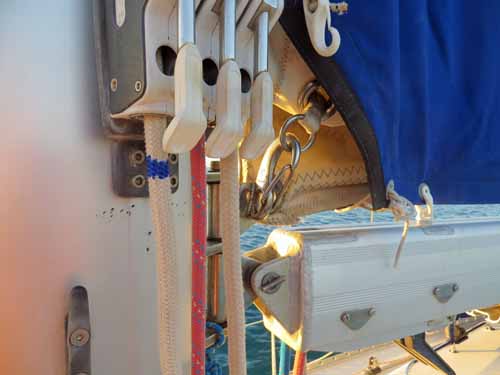Is Single Line Reefing
Right for Your Sailboat?
The single line reefing system is probably the easiest way to pull a reef in a mainsail and, providing the mainsail halyard and topping lift are led back to the cockpit, there's no need to clamber up to the mast to shorten sail.
But if the halyard and the topping lift are operated from the mast, then this is where the reefing pennant should terminate too.
On some boats the halyard is operated from the mast and the topping lift from the cockpit - which is just plain daft - but if this is the case it's best to keep the halyard and the reefing line in the same location, as you can deal with the topping lift before you leave the cockpit and when you return to it.
Clearly it makes a lot more sense to have everything all in the same place - either at the mast or in the cockpit - so you can deal with it on your own if you have to.
Pulling In a Slab with a Single Line Reefing System
It doesn't get much simpler than the external system shown here:~
 Single Line Reefing - a Simple, Seaworthy System
Single Line Reefing - a Simple, Seaworthy System- Ease the kicking strap, or vang as it's also known, then;
- Ease the mainsheet;
- Head up towards the wind;
- Take up on the topping lift to support the end of the boom;
- Release the halyard and drop the main by enough to pull in the reef;
- Pull in the reef and secure the reefing line;
- Tension halyard and secure;
- Ease the topping lift;
- Adjust course, trim sails - and it's job done!
Internal Systems
Some spar manufacturers incorporate single line systems inside the boom, which, although looking neater is:
- more expensive, and
- is difficult to repair when something breaks, and
- uses a two-part tackle which makes pulling a reef in easier, but
- the mechanical advantage works against you when letting a reef out.

There's only enough room inside the boom for the first two reef tackles, so the third reef - if there is one - has to be done with a standard slab reefing arrangement.
This means that in the very worst conditions you'll have to go to the mast anyway!
I know some offshore sailors that use this system have just two deep slabs in the mainsail, and rely on the trysail when things get really unpleasant.
The trysail should have its own separate track and be kept bagged but ready for hoisting at the foot of the mast, as shown here.
Any Questions?
What is the difference between single-line reefing and slab reefing?
What is the difference between single-line reefing and slab reefing?
The difference between single line reefing and slab reefing is that single-line reefing uses one line to pull down both the outboard and inboard reef cringles of the mainsail, while slab reefing uses two separate lines for each cringle.
Single-line reefing simplifies the reefing process and reduces the number of lines and hardware needed, but it also introduces more friction and tension in the system, which can make it harder to pull in or release the reefing line.
Slab reefing is more traditional and classic, and it allows for more precise adjustment of the luff and leech tension, but it also requires more steps and more lines to handle.
How do I convert the slab reefing system on my sailboat to a single-line mainsail reefing system?
How do I convert the slab reefing system on my sailboat to a single-line mainsail reefing system?
To convert your yacht from slab to single line reefing, you will need to modify your existing reefing system by adding some blocks, sheaves and lines that will allow you to pull down both the outboard and inboard reef cringles with one line. The exact configuration may vary depending on your boom and mast layout, but the general steps are:
- Attach a block or sheave at the end of the boom that can redirect the reefing line from the outboard cringle to the inboard end of the boom;
- Attach another block or sheave at the inboard end of the boom that can redirect the reefing line from the boom to the inboard cringle;
- Attach a block or sheave at the base of the mast that can redirect the reefing line from the inboard cringle to the cockpit;
- Run a low-stretch rope from the cockpit cleat or winch, through the mast base block, through the inboard cringle, through the boom end block, through the outboard cringle, and back to the cockpit cleat or winch. This will be your single-line reefing line;
- Remove or disable any existing lines or hardware that were used for slab reefing, such as reefing pennants or hooks.
Some tips and considerations for converting to single-line reefing are:
- Make sure all blocks, sheaves and lines are sized appropriately for your sail area and load;
- Make sure all blocks, sheaves and lines are aligned properly and run smoothly without any twists or jams;
- Make sure all blocks, sheaves and lines are secured firmly to the boom, mast and deck using rivets, screws, washers or other suitable fasteners;
- Make sure you have enough slack in your halyard and topping lift to lower your sail to the desired reef point;
- Make sure you mark your halyard and reefing line with tape or markers to indicate where to stop for each reef point.
What are the Pros and Cons of single-line reefing?
What are the Pros and Cons of single-line reefing?
Some of the advantages are:
- It reduces the number of lines and hardware needed for reefing;
- It eliminates the need to go to the mast or boom to secure the reef cringles;
- It simplifies the reefing process and reduces the risk of errors or jams;
- It allows for quick and easy adjustment of sail shape and balance.
Some of the disadvantages are:
- It produces more friction and tension than conventional reefing systems, which can make it harder to pull in or release the reefing line;
- It may not provide enough tension on the luff or leech of the sail, which can cause sagging or flapping;
- It may not work well with full-battened mainsails, which can interfere with the passage of the reefing line through the cringles.
How do I shake out a reef using a single-line reefing system?
How do I shake out a reef using a single-line reefing system?
To shake out a reef using a single-line reefing system, you need to:
- Ease off or release any vang, outhaul or mainsheet tension that may prevent you from lowering or raising your mainsail;
- Ease off or release the reefing line until both the outboard and inboard cringles are free from the boom. Cleat off or lock the reefing line;
- Raise the mainsail halyard until you reach a pre-marked point that corresponds to the original sail area or the next lower reef point;
- Re-tension the reefing line to remove any slack or wrinkles from the leech of the sail. Cleat off or lock the reefing line;
- Adjust the vang, outhaul and mainsheet as needed to trim and shape your full or partially reefed sail.
The above answers were drafted by sailboat-cruising.com using GPT-4 (OpenAI’s large-scale language-generation model) as a research assistant to develop source material; to the best of our knowledge, we believe them to be accurate.
Recent Articles
-
Used Sailing Equipment For Sale
May 15, 24 02:04 AM
Here's where people with sailing equipment for sale advertise their stuff entirely free of charge. If you're looking for used sailing gear or other used boating accessories, here's where to find it! -
The Jeanneau Sun Odyssey 54 DS Sailboat
May 14, 24 11:44 AM
Interested in the Jeanneau Jeanneau Sun Odyssey 54 DS sailboat? Here are the pics, specs and performance predictions you're looking for... -
The Jeanneau Sun Fast 39 Sailboat
May 14, 24 10:56 AM
Interested in the Jeanneau Sun Fast 39 sailboat? Here are the pics, specs and performance predictions you're looking for...















